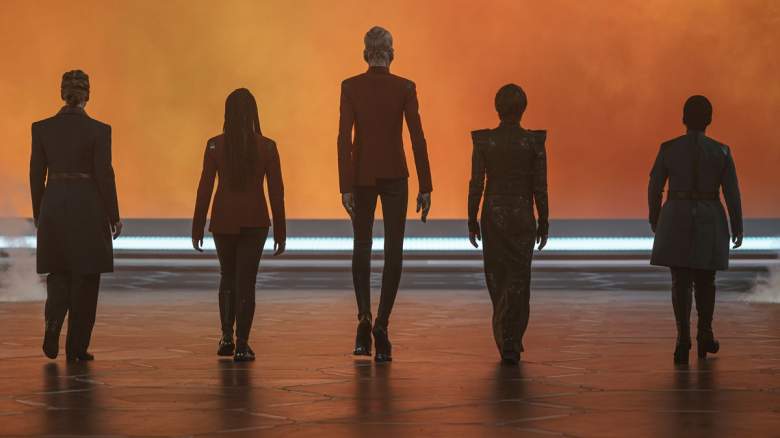
Marni Grossman / Paramount “Star Trek: Discovery” and the mysterious Species 10-C
Fans of “Star Trek” are well aware of the mission and mantra of the show. As recited first by William Shatner for “The Original Series,” the show promised to “seek out new life and new civilizations.”
For “The Next Generation,” and with Patrick Stewart’s voice, the message was updated a bit to say “to boldly go where no one has gone before.” And soon, this matra may be recited by Anson Mount, whose Captain Christopher Pike will soon say on his show, “Strange New Worlds.”
One thing that has remained constant from the start of Trek is that nearly all aliens were humanoid. This was due initially to the budgetary constraints of the time. Gene Roddenberry laid that out plainly in a written pitch for the show. This document was used to sell the show to the networks and ultimately got the first pilot made in 1964.
“Although it would be foolish to state we will never do a ‘monster’ episode, most casting will be fairly routine,” Roddenberry wrote in the pitch document. “Where required, ‘alien’ variations will be obtained by padding, wigs, and simpler makeup devices.”
The Horta
Aside from a few “monsters,” like the Horta in “The Devil in the Dark,” most of the aliens that Kirk (Shatner), Spock (Leonard Nimoy), and the rest of the crew encountered were like us. They had a head, two eyes, a mouth, two arms, and so forth.
In 1987, when “The Next Generation” launched into syndication, using human actors for aliens remained how it was done generally. There were a few instances where Picard faced off against non-humanoid life — like the Sheliak, who appeared in the episode “The Ensigns of Command.”
Humanoid aliens were then further cemented into canon with the episode “The Chase,” which told the story of a race of humanoids who seeded the galaxy with beings that resembled themselves. This idea was borrowed from the 1970s book and film “Chariots of the Gods,” which supposed that aliens actually did seed Earth to create life.
‘Species 10-C’
Even alien language was similar. Most aliens spoke with their mouths, and the universal translator converted that audible speech into nearly any language. Exceptions include the classic TNG episode “Darmock” and the “Deep Space Nine” comedic story, “Little Green Men.”
But now, thanks to the Season 4 “Star Trek: Discovery” episode, “Species 10-C,” fans are treated to what might be the most realistic encounter between humans (and humanoids) and alien life. Species 10-C, according to showrunner Michelle Paradise, is “unlike a species we’ve seen before.” Paradise shared her thoughts earlier this season with CinemaBlend.
‘Arrival’
While this is true, the way the species communicates is very similar to what moviegoers saw in the 2016 film “Arrival.” That story was centered around a species of aliens who visited Earth. Their language was so different that it took weeks for a linguist and researcher (played by Amy Adams) to figure out.
Unlike “Arrival,” the writing team behind “Discovery” used the theory that mathematics might be the only real way for two species to communicate. This is not a sci-fi creation but an actual idea from scientists.
Mathematician Carl DeVito proposed that a language based on universal scientific concepts might be a way for “us” to talk to intelligent alien life.
“The concept of first attracting attention and then displaying meaning is, perhaps, the best way to solve the problem,” DeVito said (as reported by Space.com). “Maybe extraterrestrial intelligence will have similar ideas and thereby make themselves known to us.”
‘2001’
“Species 10-C” also borrowed ideas from “2001: A Space Odyssey.” When the 10-C invited Captain Burnham (Sonequa Martin-Green), Saru (Doug Jones), and the others into a space to better communicate, it was designed to put the humans at ease. This is much like how the mysterious aliens in “2001” created a room to make astronaut Dave Bowman (Keir Dullea) comfortable.
Meanwhile, Ruon Tarka (Shawn Doyle) continued to scheme to find a way to destroy the DMA, which is the powerful mining device controlled by Species 10-C. Cleveland “Book” Booker (David Ajala) realized that Tarka still intended to destroy the DMA, even though Burnham and Saru made this critical communications breakthrough. Fans will have to find out on the season finale (Episode 13) to learn how this is all resolved.
While weaving together a compelling narrative of politics, feeling, and science fiction, the creative team at “Star Trek: Discovery” may have put together the most scientifically accurate episode of Trek yet. That is, when it comes to communicating with alien life. The Spore Drive is complete fiction, as explained by Forbes’ Linh Anh Cat.
READ NEXT: ‘Star Trek’ Actor John De Lancie Shares What’s Coming in Picard: Season 2
Comments
How ‘Star Trek: Discovery’ Truly Went Somewhere No Trek Has Gone Before